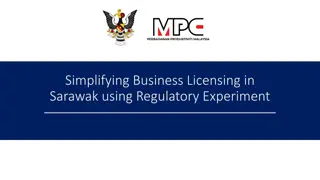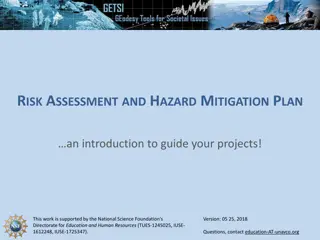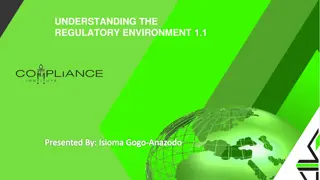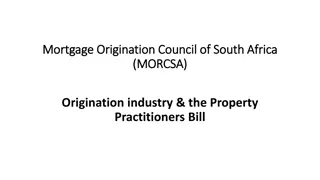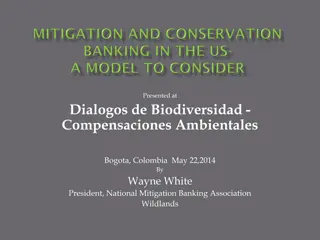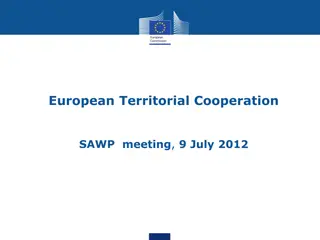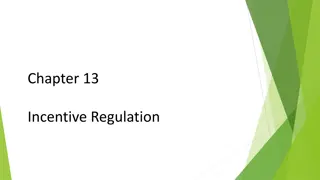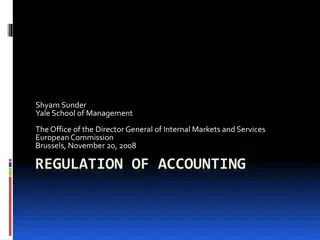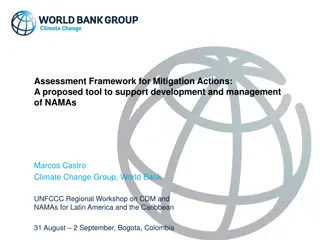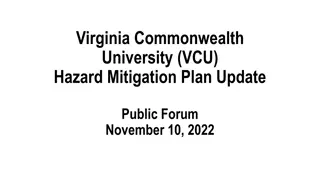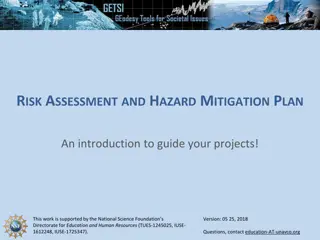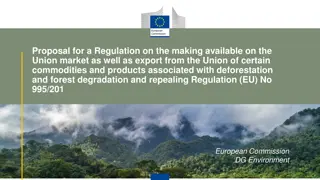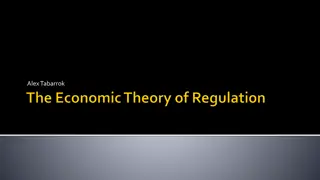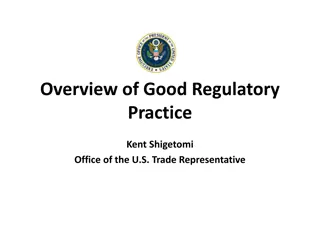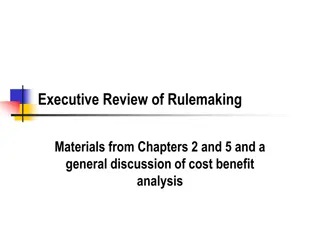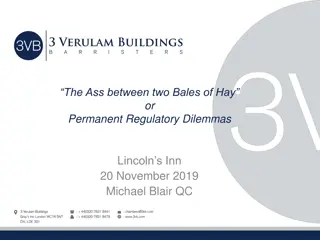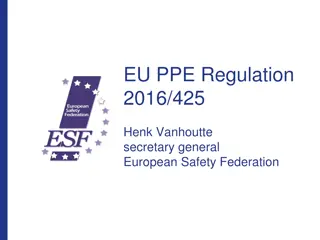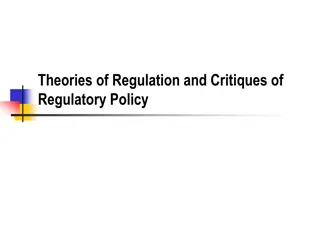Mitigation of Regulatory Capture in Economic Regulation
Regulation aims to correct market failures for societal welfare, but regulatory capture by interest groups can hinder regulatory actions. This work discusses economic theories on regulatory capture, forms of capture, and strategies to mitigate risks, emphasizing the public interest theory as a promoter of economic efficiency.
Download Presentation

Please find below an Image/Link to download the presentation.
The content on the website is provided AS IS for your information and personal use only. It may not be sold, licensed, or shared on other websites without obtaining consent from the author. Download presentation by click this link. If you encounter any issues during the download, it is possible that the publisher has removed the file from their server.
E N D
Presentation Transcript
Regulation and Regulatory Capture Maria Rosa Borges mrborges@iseg.utl.pt ISEG (Lisbon School of Economics and Management) of the Universidade de Lisboa UECE (Research Unit on Complexity and Economics) XIV International Colloquium Cape Town May 10-12, 2017 XIV International Colloquium - Cape Town 2017
3. Mitigation of regulatory capture 1. Economic regulation 2. Regulatory capture Introduction 4.Conclusions Introduction Regulation exists to correct the negative effects of market failures in the welfare of the society. But a major problem arises: Regulatory action may be impaired by the existence of interest groups that seek to condition regulators in a way that their decisions became favorable to the interest groups goals. In this work, we present and discuss the different economic theories that provide insights into the problem of regulatory capture; we present several forms in which regulatory capture may occur; and we discuss how to mitigate the risk of regulatory capture. 2 XIV International Colloquium - Cape Town 2017
3. Mitigation of regulatory capture 1. Economic regulation 2. Regulatory capture Introduction 4.Conclusions Structure of the presentation 1. First, we begin by contextualizing regulation, based on public interest theory as a promoter of economic efficiency; and we discuss the several theories that seek to explain the problem of regulatory capture by interest groups; Secondly, we examine the ways that regulatory capture may materialize. This analysis focuses on cultural capture and financial capture; Thirdly, we discuss some of the measures that may contribute to mitigate regulatory capture; And finally, we draw the conclusions. 2. 3. 4. 3 XIV International Colloquium - Cape Town 2017
3. Mitigation of regulatory capture 1. Economic regulation 2. Regulatory capture Introduction 4.Conclusions The concept From a broad perspective, economic regulation encompasses all forms of state intervention in the economy (Dal B , 2006). A more specific and more common definition of economic regulation presumes significant state intervention in industries with market power or that produce "essential" goods or services, with the aim of increasing social welfare. 4 XIV International Colloquium - Cape Town 2017
3. Mitigation of regulatory capture 1. Economic regulation 2. Regulatory capture Introduction 4.Conclusions The public interest theory The public interest theory was the standard economic thinking on regulation from the late nineteenth century until the late 1960s. This theory is based on two basic assumptions. Firstly, markets are extremely fragile and likely to work inefficiently if we let them operate autonomously. Secondly, government regulation can correct these shortcomings, i.e., it can compensate for social welfare losses associated with market failures (McCraw, 1975). 5 XIV International Colloquium - Cape Town 2017
3. Mitigation of regulatory capture 1. Economic regulation 2. Regulatory capture Introduction 4.Conclusions The public interest theory On the basis of these assumptions, the main public interventions in the economy can be seen as the government's response to the need to rectify the inefficiencies resulting from the free functioning of markets (Posner, 1974). Interventions: protection of trade unions, regulation of utilities and natural monopolies, subsidies to agriculture, minimum wages, price and quantity control, etc. 6 XIV International Colloquium - Cape Town 2017
3. Mitigation of regulatory capture 1. Economic regulation 2. Regulatory capture Introduction 4.Conclusions The public interest theory Public intervention requires, the identification of market anomalies and the definition of a corrective policy of those failures (Pigou, 1932). Problems such as monopolies/oligopolies or externalities. Economic regulation, viewed from this perspective, promotes productive efficiency and an adequate allocation of resources, and protects consumers from market power abuse by monopoly sectors (Laffont, 2005). 7 XIV International Colloquium - Cape Town 2017
3. Mitigation of regulatory capture 1. Economic regulation 2. Regulatory capture Introduction 4.Conclusions Regulatory capture theories The existence of regulation does not in itself ensure that the objectives it pursues are met, because regulators are permeable to private interests; regulatory capture may occur by the firms that are subject to regulation. The theory of regulatory capture has several versions. It is common to all those versions that economic capture is a process by which interest groups seek to promote their private interests. 8 XIV International Colloquium - Cape Town 2017
3. Mitigation of regulatory capture 1. Economic regulation 2. Regulatory capture Introduction 4.Conclusions Regulatory capture theories One version of this theory stems from political science, particularly from the works of Bentley (1908) and Truman (1951), who emphasize the importance of interest groups in shaping public policy. A specific interest group - the regulated firms - prevails in the dispute to influence the legislation. In a more theoretical approach, regulatory capture occurs when groups of individuals or firms that, having an interest in the outcome of regulatory policy decisions, direct their efforts and affect their resources in seeking to achieve the desired outcomes of those policies. 9 XIV International Colloquium - Cape Town 2017
3. Mitigation of regulatory capture 1. Economic regulation 2. Regulatory capture Introduction 4.Conclusions Regulatory capture theories In this context, a more precise concept of regulatory capture, is connected to the success in influencing (capturing) legislators or regulatory agencies, So that policies and legislation preferred by regulated firms are implemented. a) Regulation as a market The economic theory of regulation is initially proposed by Stigler who, in 1971, introduces a new aspect in the theory: the idea that economic regulation can be seen as a product whose optimal allocation derives from the demand and supply interaction. 10 XIV International Colloquium - Cape Town 2017
3. Mitigation of regulatory capture 1. Economic regulation 2. Regulatory capture Introduction 4.Conclusions a) Regulation as a market Stigler emphasizes that traditional mechanisms for obtaining monopoly rents are less efficient ways to gain benefits than to use their power to influence legislators or regulatory agencies to obtain "legal" protection against competition. Thus, in contrast to the public interest theory of regulation, Stigler's view is that regulation serves the private interests of regulated firms In this sense, regulation can be seen as an economic good for which there is a supply and demand market in which legislators offer regulation and interest groups seek regulation that favors them. 11 XIV International Colloquium - Cape Town 2017
3. Mitigation of regulatory capture 1. Economic regulation 2. Regulatory capture Introduction 4.Conclusions b) Interest group theory A different perspective is developed by Peltzman (1976), Posner (1971, 1974, 1975) and Becker (1983) - the interest group theory. Peltzman (1976) introduces the notion that no economic interest captures legislators or regulatory agencies with exclusivity. There are different interest groups (not only one) competing for making their interests prevail. The problem for legislators and regulatory agencies is to determine the efficient level of regulation, which must be an optimal balance between the various interest groups in society, while at the same time maximizing political support. 12 XIV International Colloquium - Cape Town 2017
3. Mitigation of regulatory capture 1. Economic regulation 2. Regulatory capture Introduction 4.Conclusions c) Regulation and corruption De Soto (1989) and Shleifer and Vishny (1994, 1998) introduce new ideas, formulating the so-called toll theories. This approach highlight the benefits that legislators and regulatory agencies can gain by having a monopoly position that allows them to create inefficient laws and regulations, extracting revenues from regulated firms through bribes or campaign contributions. To gain benefits, interest groups pay "tolls" to legislators and regulatory agencies. Corruption of legislators or regulatory agencies is, in this perspective, seen as a way of overcoming inefficiencies in regulation. 13 XIV International Colloquium - Cape Town 2017
3. Mitigation of regulatory capture 1. Economic regulation 2. Regulatory capture Introduction 4.Conclusions d) Other theories Laffont and Tirole (1991, 1993) and Boehm (2007) develop a theory of regulatory capture, based on information asymmetry and the principal- agent theory. While the regulatory agency has resources to discover whether regulated firm is efficient or inefficient (by supervising the prices and rates of return of regulated firms), the legislators (the principal) have to rely on the information provided by regulators. In this context, it is possible that the regulatory agency may omit information from legislators and obtain economic advantages from collusion with the regulated firm, if that firm benefits from the retention of information. 14 XIV International Colloquium - Cape Town 2017
3. Mitigation of regulatory capture 1. Economic regulation 2. Regulatory capture Introduction 4.Conclusions d) Other theories Martimort (1999) and Estache and Martimort (1999) explain regulatory capture by the regulatory life cycle theory. When the regulatory agency is young, it tends to be under tight scrutiny on the part of legislators and the general public. Over time, scrutiny is reduced, and the agency receives less public attention, reducing consumer pressure on issues of regulatory effectiveness. Meanwhile, pressure from the interest groups of regulated firms remains high, which translates into a growing risk of regulatory capture over time. 15 XIV International Colloquium - Cape Town 2017
3. Mitigation of regulatory capture 1. Economic regulation 2. Regulatory capture Introduction 4.Conclusions d) Other theories Zingales (2013) further points out that regulatory capture may occur as a consequence of the regulatory agency being able to protect itself against any mistakes it may make. If the regulator makes a mistake that harms the regulated firms, the consequence will be that regulated firms will complain strongly. On the other hand, if the error is detrimental to consumers, the most normal situation is that this error will not be noticed. In this context, it makes more sense for the regulatory agency to take fewer risks, making decisions that do not tend to harm regulated firms. 16 XIV International Colloquium - Cape Town 2017
3. Mitigation of regulatory capture 1. Economic regulation 2. Regulatory capture Introduction 4.Conclusions Forms of regulatory capture Ex-ante capture is defined as the set of influences that are exercised in the process of defining the rules and regulations. It occurs when regulated firms are able to influence the legislation and regulation to their benefit, before it takes effect. In this case, rules and regulation are respected without the need to affect additional resources and efforts to try to subvert unfavorably defined rules. This type of capture corresponds to high-level corruption, at the level of politicians, legislators and other state agents. Ex-post capture seeks to influence regulatory agencies with the goal of avoiding compliance with existing rules and regulations, possibly through bureaucratic corruption. 17 XIV International Colloquium - Cape Town 2017
3. Mitigation of regulatory capture 1. Economic regulation 2. Regulatory capture Introduction 4.Conclusions Forms of regulatory capture Financial capture occurs when the motivation of the regulatory agent is of a material nature, and may result from bribes, contributions and political donations, etc. Tends to occur in countries with authoritarian political systems or fragile democracies. Cultural capture occurs when the regulator begins to think like the firms in the regulated sector, reflecting a strong social identification with it. Tends occur in countries with higher levels of economic and social development. In this last case, the regulator is not materially corrupted; it accepts the influence, values and interests of regulated firms, which he believes are convergent with the interests of consumers and society. 18 XIV International Colloquium - Cape Town 2017
3. Mitigation of regulatory capture 1. Economic regulation 2. Regulatory capture Introduction 4.Conclusions Cultural capture Individuals who know the industry best tend to be those who work in this industry, including technicians, operators, scientists and managers. One can work a few years in an industry, then a few years in the regulatory body of that industry and later return to work in a regulated firm, which has been termed the "revolving door" problem. Dal B (2006) argues that the fact that many regulators come from the regulated industry or end up working for this industry has long been believed to be a source of disturbance to the quality of regulation. 19 XIV International Colloquium - Cape Town 2017
3. Mitigation of regulatory capture 1. Economic regulation 2. Regulatory capture Introduction 4.Conclusions Cultural capture Zingales (2013) identifies the concerns of regulators regarding their careers as one of the important channels for regulatory capture. Regulatory agents have an economic interest in being offered employment proposals. Kwak (2014) argues that the problem of regulatory capture is best explained by a cultural perspective - where regulatory agents identify with the industry. The regulatory agent does not compromise its principles, but its actions and beliefs tend to be strongly aligned with the interests of regulated firms, continuing to believe that they are consistent with the public interest. 20 XIV International Colloquium - Cape Town 2017
3. Mitigation of regulatory capture 1. Economic regulation 2. Regulatory capture Introduction 4.Conclusions Cultural capture The risk of cultural capture increases when: regulators have close relationships with industry; They have and professional affinities with people working in regulated businesses; and they have regular working and negotiating meetings. In these cases, the regulatory agent may feel more identified with the regulated firms, and he internalize the objectives, norms and values of the industry through a process of social identification (Buiter, 2009; McPhilemy, 2013). 21 XIV International Colloquium - Cape Town 2017
3. Mitigation of regulatory capture 1. Economic regulation 2. Regulatory capture Introduction 4.Conclusions i. Controls and limiting discretion As noted by Baxter (2011), strategies for mitigating the risk of regulatory capture require a multiple approach method, with several mutually complementary measures, including: the implementation of control mechanisms, sanctions and rewards, taking into account the potentially perverse effects of such measures. It is necessary to find a balance that, by limiting discretion of regulatory agency, does not compromise the independence and autonomy of the regulatory agency. 22 XIV International Colloquium - Cape Town 2017
3. Mitigation of regulatory capture 1. Economic regulation 2. Regulatory capture Introduction 4.Conclusions ii. Transparency and accountability Boehm (2007) argues that to achieve this balance is necessary to increase transparency and accountability of regulatory decisions and processes. Transparency helps reduce the information asymmetries between the regulator and politicians, and between the regulator and the regulated firms 23 XIV International Colloquium - Cape Town 2017
3. Mitigation of regulatory capture 1. Economic regulation 2. Regulatory capture Introduction 4.Conclusions iii. Anti-corruption measures Boehm (2007) proposes some anti-corruption measures that can mitigate the risk of financial capture, including: promoting the rotation of regulators in vulnerable positions; regulated firms should always be visited in teams of at least two technicians and, if possible, with team rotation; relations between regulators and regulated firms should be kept as anonymous as possible; regulatory agents should be barred from working for the industry or regulated sector for a period of time; the regulatory agency should be staffed by technical staff in adequate quantity and quality; introduce rules to encourage anonymous complaints, and protect whistleblowers. 24 XIV International Colloquium - Cape Town 2017
3. Mitigation of regulatory capture 1. Economic regulation 2. Regulatory capture Introduction 4.Conclusions iv. Other mitigating measures Baxter (2011) states that the different forms of mitigation of regulatory capture may include: ensuring the participation of groups representing the interests of consumers in the regulatory process; limiting the size and hence the influence of regulated firms; implementing duly structured regulatory agencies with adequate, well-paid resources and clearly defined missions. 25 XIV International Colloquium - Cape Town 2017
3. Mitigation of regulatory capture 1. Economic regulation 2. Regulatory capture Introduction 4.Conclusions iv. Other mitigating measures Berry (1979) points out that regulatory agencies are less susceptible to regulatory capture when they have higher budgets and restrictive recruitment policies, a proxy for the regulator's professionalism. Veltrop and Haan (2014) argue that reinforcing the professional identification of regulators is a way of combating their personal and social identification with the sector they regulate. This can be achieved by stimulating their professional identity as regulators, including training actions, integration into professional groups, and participation in regulatory associations. 26 XIV International Colloquium - Cape Town 2017
3. Mitigation of regulatory capture 1. Economic regulation 2. Regulatory capture Introduction 4. Conclusions Conclusions It is important to recognize that different interest groups influence the regulatory process. What needs to be ensured is that none of these interest groups can achieve a disproportionate level of influence. In practical terms, it is necessary to put in place mechanisms and incentives that make public interest groups more active in the regulatory process, and in negotiations between regulatory agencies and regulated firms. 27 XIV International Colloquium - Cape Town 2017
3. Mitigation of regulatory capture 1. Economic regulation 2. Regulatory capture Introduction 4. Conclusions Conclusions At the same time, regulatory agencies: should have clear missions; should promote transparency and participation of the various interest groups in public discussions and negotiations; should be provided with adequate human and financial resources; should adequately remunerate their expert technicians; and should promote their professional identity as regulators, to reduce their social identification with the regulated sector, and the risk of capture. 28 XIV International Colloquium - Cape Town 2017
THANK YOU XIV International Colloquium - Cape Town 2017 29


